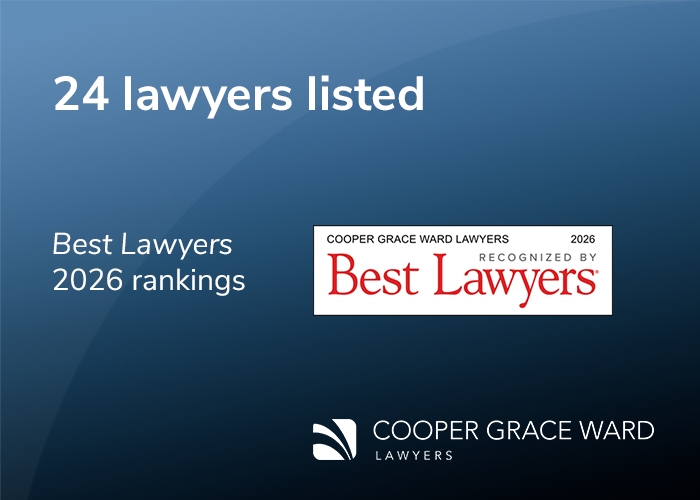When a company is facing short term financial difficulties the directors or shareholders may decide to make a loan to the company to pay wages.
If the loan transaction complies with the requirements of section 560 of the Corporations Act 2001 (Cth) (Act), the third party making the loan to the company can, in the liquidation of the company, seek to be subrogated to the priority position enjoyed by employees in front of ordinary unsecured creditors. The third party can also, in some situations, claim priority over a security interest in respect of circulating assets (previously known as floating charge assets).
However, a worrying number of loans do not comply with section 560, resulting in the lenders losing the priority to which they would otherwise be entitled.
Section 560
The elements of section 560 are:
- a company must make a payment on account of:
- wages; or
- superannuation contributions (within the meaning of section 556 of the Act); or
- in respect of leave of absence, or termination of employment, under an industrial instrument; and
- the payment made by the company must be made as a result of an advance of money by a person for the purpose of making the payment.
To the extent that such a loan remains unpaid when the company is wound up, the third party making the loan is able to stand in the shoes of an employee and recover the same statutory priority that an employee would receive if the payment had not been made to the employee.
2007 change to the wording of section 560
Before 2007, the section required the payment to the employee to be made ‘out of’ the advance. The section now requires the payment to the employee to be made ‘as a result of’ the advance.
Under the pre-2007 authorities, section 560 did not apply if the payments to the employees were made from a company account in debit or if the amounts advanced were mingled with other money.
The practical difficulty in relation to the pre-2007 wording is demonstrated by the decision in Capt’n Snooze Management Pty Ltd v McLellan [2002] VSC 432.
In Capt’n Snooze, the third party advanced money to the company under a written loan agreement for the express purpose of enabling the company to pay employee entitlements under section 560. The third party paid the advance to the company’s overdraft cheque account and the employees were then paid from the overdraft account.
The third party was unsuccessful under section 560. The Court said the employees were not paid out of the third party advance because the deposit made by the third party reduced the debit balance of the company’s overdraft account and the payments made to the employees from the overdraft account constituted a loan by the bank to the company.
It remains to be seen if the courts decide there is any difference between the earlier requirement that the payment be made ‘out of’ the advance and the current requirement that the payment be made ‘as a result of’ the advance.
It would be prudent when making a loan to the company to proceed on the basis that the decision in Capt’n Snooze still applies.
Dalma Constructions
In Re Dalma No. 1 Pty Ltd (in liq.) [2013] NSWSC 1335, the third party providing the funds was an entity related to the company in liquidation. The third party was unsuccessful because the third party had paid the contributions directly to the employees.
The Court, considering the post-2007 wording, said:
- The reference in section 560 to an ‘advance’ of money is to a loan to the company, which creates a debtor-creditor relationship, as distinct from a gift or transfer to the company to be held on trust.
- Section 560 only applies where the company (i.e. the company being wound up) pays the employee-related liabilities itself, using money lent to it by the donor.
- The third party was not entitled to be subrogated under section 560 because the company in liquidation did not pay the employee-related liabilities using money lent to it by the third party. The third party had paid those liabilities directly itself.
Practical suggestions for satisfying section 560
To satisfy the requirements of section 560 it would be prudent to ensure:
- there is a written loan agreement recording the purposes of the advance;
- the advance is for one of the designated purposes in section 560;
- the third party does not make the payment directly to the employees;
- the third party does not pay the advance into an overdraft account, an overdrawn account of the company or into an account mixed with other money;
- the company establishes a separate bank account to be used only for the purpose of receiving the advance and making the payment to the employees;
- the company actually uses the advance to make the payments to the employees; and
- the company keeps appropriate payroll records and supporting documents to record the causal link between the making and receipt of the loan from the third party and the payment made to the employees for the designated purpose.
The identity of the third party making the advance also needs to be considered.
Excluded employees
Under the Act, directors of a company, their spouses and relatives are ‘excluded employees’ in respect of the company.
In a winding-up there are statutory restrictions on the amounts that can be personally claimed by an excluded employee for statutory employee entitlements. The monetary restrictions also apply to an excluded employee seeking to be subrogated to a priority position under section 560.
For example, an excluded employee can only claim a maximum priority payment of $2,000 for wages and superannuation. In the absence of any security, the balance of their claim would be as an ordinary unsecured creditor.
So as not to be caught by the monetary restrictions applying to ‘excluded employees’, consideration should be given to a related entity making the advance.
Of course, if an excluded employee has existing security it may be preferable for the excluded employee to make the advance relying upon their existing security. This will depend upon the enforceability and strength of the existing security as well as the financial circumstances of the company.
The fact that a third party has security does not prevent a third party from making a claim for subrogation under section 560.
Conclusion
If a third party intends to make a loan to a company to enable it to pay wages, it would be prudent for the third party to implement the transaction so as to comply with the requirements of section 560. This may improve the recovery prospects of the third party on the winding-up of the company.
The identity of the proposed lender and issues relating to security will need to be considered.
If you would like more information about these issues, please contact Graham Roberts on +61 7 3231 2404.



